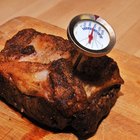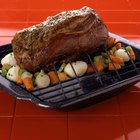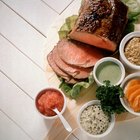bhofack2/iStock/GettyImages
A handful of manufacturers produce heatproof bags for roasting meats and poultry. They capture the moisture that would otherwise evaporate from the meat, shortening your cooking time and keeping the meat moist. That's a great convenience with premium roasts such as prime rib, which remain extra-tender and juicy when roasted in an oven bag. The only flaw in the process is that the roast won't gain a well-browned exterior, but you can do that before you put it in the bag.
Trim the rind of fat on the outside of your roast with a sharp knife, leaving 1/4 inch or less. Ordinarily the fat would help protect your roast from drying, but it's not necessary inside an oven bag.
Heat a large skillet over medium-high heat, then add a tablespoon of cooking oil. Sear your prime rib on all sides, except where it's impossible because of the bones. Season the roast liberally with salt and pepper, or any other flavorings you wish.
Shake a tablespoon of flour in the bag to coat its inner surfaces, then shake out any excess and place the bag in a large roasting pan. Coarsely chop a handful each of carrot and celery, and two handfuls of onion, and place them in the bottom of the bag. This step is optional, but it will make your gravy taste better.
Slide the browned roast carefully into the bag, taking care not to let the ends of the rib bones puncture it. Wrapping the ends of the rib bones in cheesecloth can help minimize the risk. Seal the bag with the provided ties, and carefully snip four to six small slits in it for ventilation.
Roast the beef in a preheated oven at 325 degrees Fahrenheit for 20 to 25 minutes per pound, or until it reaches your desired degree of doneness when tested with an instant-read thermometer.
Remove the roaster from your oven and carefully slit open the bag, avoiding the hot steam that will escape. Transfer the roast to a serving tray and cover it loosely with foil. Strain and defat the drippings, and thicken them to make gravy if you wish. Rest the beef for at least 10 to 15 minutes before carving it.
Related Articles

How to Use Reynolds Oven Bags

How to Cook Bottom Round Roast in a ...

How to Cook a Roast in a Bag
How to Cook Chuck Roast in a Baking Bag
How to Slow Cook a Pot Roast With Beef ...
How to Cook a Brisket in a Bag

How to Cook a Whole Sirloin Tip Beef ...

How Do Cooking Bags Shorten Cooking ...

How to Make Pot Roast in a Cooking Bag

How to Slow Cook an Eye of Round Roast ...

Baking Pork Tenderloin, Potatoes & ...
How to Cook Buffalo Fillet

How to Marinate a Top Round Roast

How to Cook a Beef Roast in a Roaster ...

How to Cook a 15-Pound Rib Roast

How to Convection Roast a Brisket

How to Sear a Roast Beef

How to Defrost a Frozen Beef Roast in ...
How to Cook a Lamb Square Cut Shoulder

How to Cook the Neck of a Deer
References
Tips
- The USDA's recommended temperature for beef is 145 degrees, but most diners prefer their prime rib cooked only to rare or medium-rare. For rare beef, take the roast out of the oven when its internal temperature reaches 110 to 115 degrees. For medium-rare, take it out of the oven at 115 to 120 degrees. The roast will continue cooking as it rests because of residual heat trapped inside the meat.
- To brown the meat on all sides, cut it away from the rib bones and sear it in the skillet. When the meat is thoroughly browned, use butcher's twine to tie it back onto the bones. When the roast has finished resting, snip the twine and release it from the bones for easy carving.
Writer Bio
Fred Decker is a trained chef and prolific freelance writer. In previous careers, he sold insurance and mutual funds, and was a longtime retailer. He was educated at Memorial University of Newfoundland and the Northern Alberta Institute of Technology. His articles have appeared on numerous home and garden sites including GoneOutdoors, TheNest and eHow.